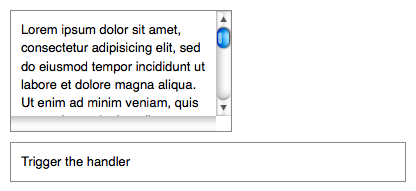.scroll()
Bind an event handler to the "scroll" JavaScript event, or trigger that event on an element.
.scroll(function(eventObjectEvent))🡢 jQuery
function(eventObjectEvent)
| Function | A function to execute each time the event is triggered. |
.scroll(eventData, function(eventObjectEvent))🡢 jQuery
eventData
| Anything | An object containing data that will be passed to the event handler. |
function(eventObjectEvent)
| Function | A function to execute each time the event is triggered. |
.scroll()🡢 jQuery
This method is a shortcut for .on( "scroll", handler ) in the first and second variations, and .trigger( "scroll" ) in the third.
The scroll event is sent to an element when the user scrolls to a different place in the element. It applies to window objects, but also to scrollable frames and elements with the overflow CSS property set to scroll (or auto when the element's explicit height or width is less than the height or width of its contents).
For example, consider the HTML:
<div id="target" style="overflow: scroll; width: 200px; height: 100px">
Lorem ipsum dolor sit amet, consectetur adipisicing elit, sed do eiusmod
tempor incididunt ut labore et dolore magna aliqua. Ut enim ad minim veniam,
quis nostrud exercitation ullamco laboris nisi ut aliquip ex ea commodo
consequat. Duis aute irure dolor in reprehenderit in voluptate velit esse
cillum dolore eu fugiat nulla pariatur. Excepteur sint occaecat cupidatat non
proident, sunt in culpa qui officia deserunt mollit anim id est laborum.
</div>
<div id="other">Trigger the handler</div>
<div id="log"></div>
The style definition is present to make the target element small enough to be scrollable:

The scroll event handler can be bound to this element:
$("#target").scroll(function () {
$("#log").append("<div>Handler for .scroll() called.</div>");
});
Now when the user scrolls the text up or down, one or more messages are appended to <div id="log"></div>:
Handler for .scroll() called.
To trigger the event manually, apply .scroll() without an argument:
$("#other").click(function () {
$("#target").scroll();
});
After this code executes, clicks on Trigger the handler will also append the message.
A scroll event is sent whenever the element's scroll position changes, regardless of the cause. A mouse click or drag on the scroll bar, dragging inside the element, pressing the arrow keys, or using the mouse's scroll wheel could cause this event.
To do something when your page is scrolled:
<div>Try scrolling the iframe.</div>
<p>Paragraph - <span>Scroll happened!</span></p>
div {
color: blue;
}
p {
color: green;
}
span {
color: red;
display: none;
}
$("p").clone().appendTo(document.body);
$("p").clone().appendTo(document.body);
$("p").clone().appendTo(document.body);
$(window).scroll(function () {
$("span").css("display", "inline").fadeOut("slow");
});